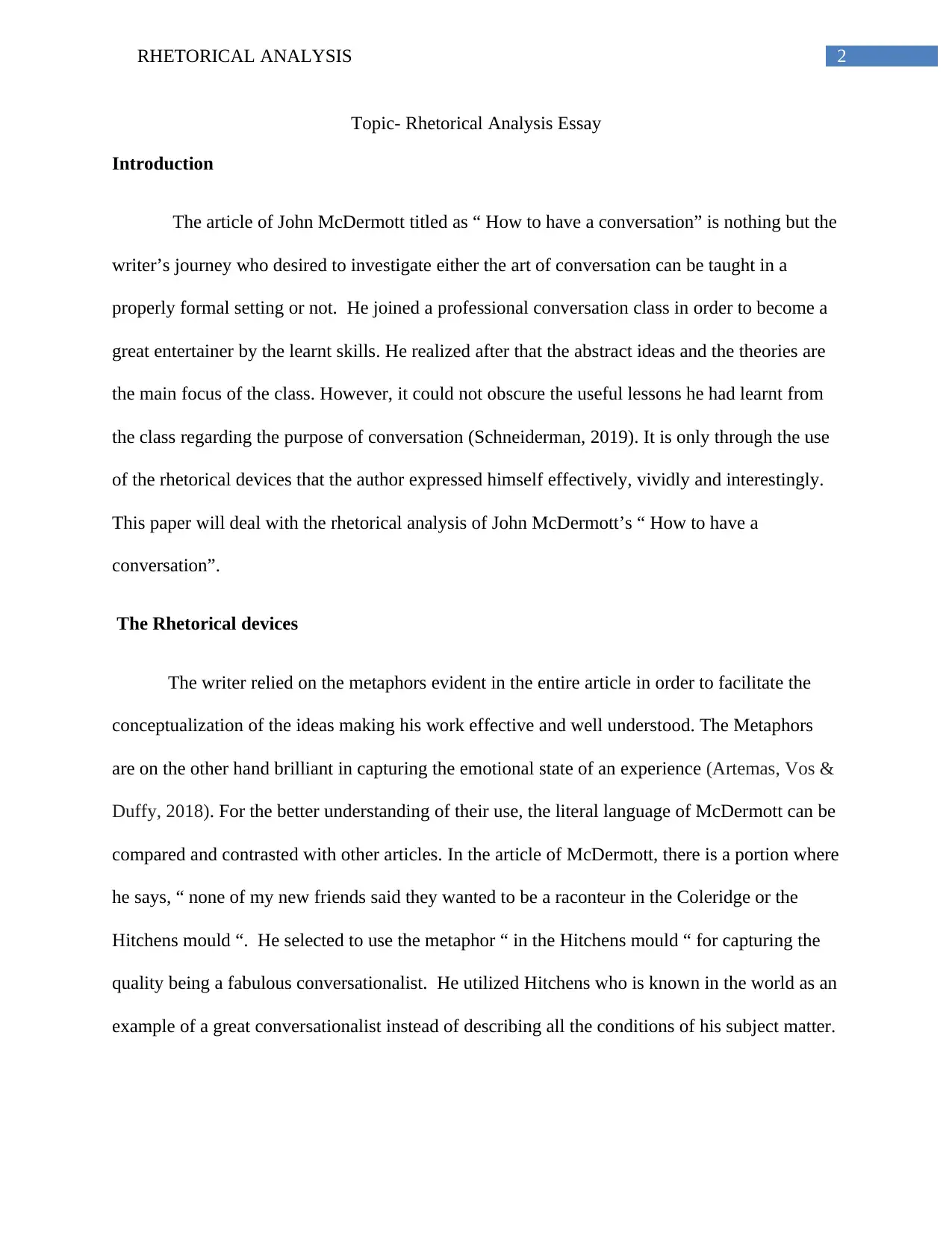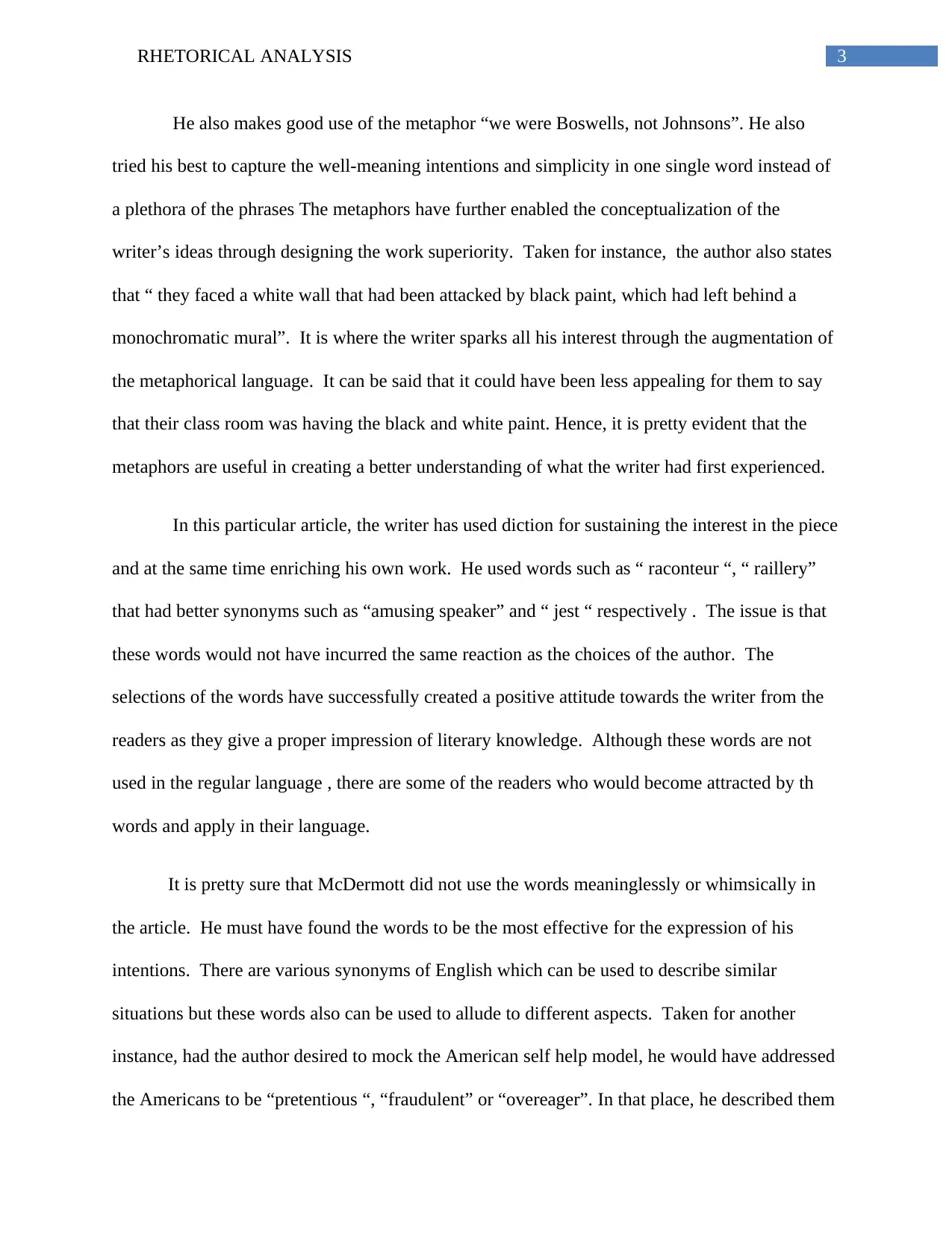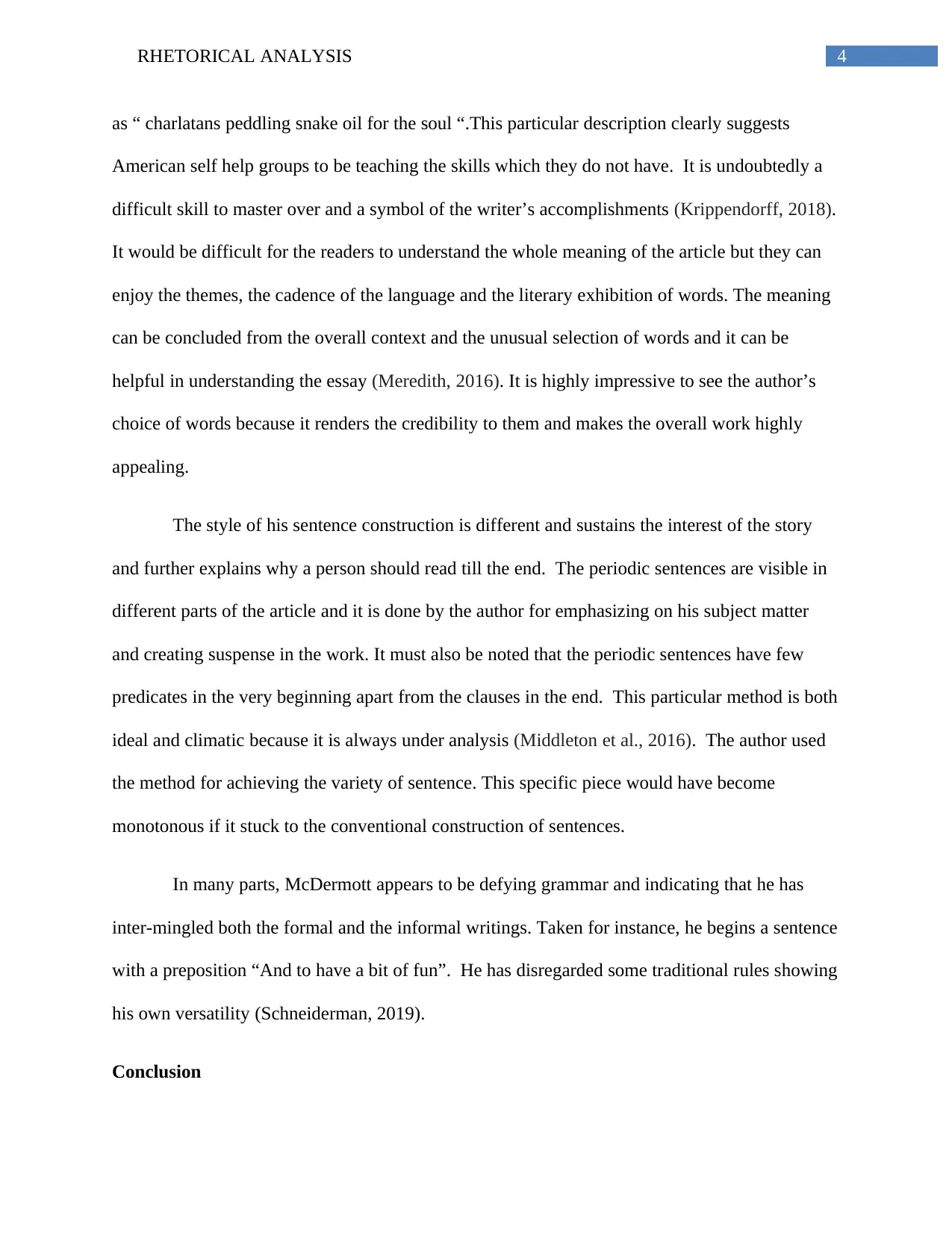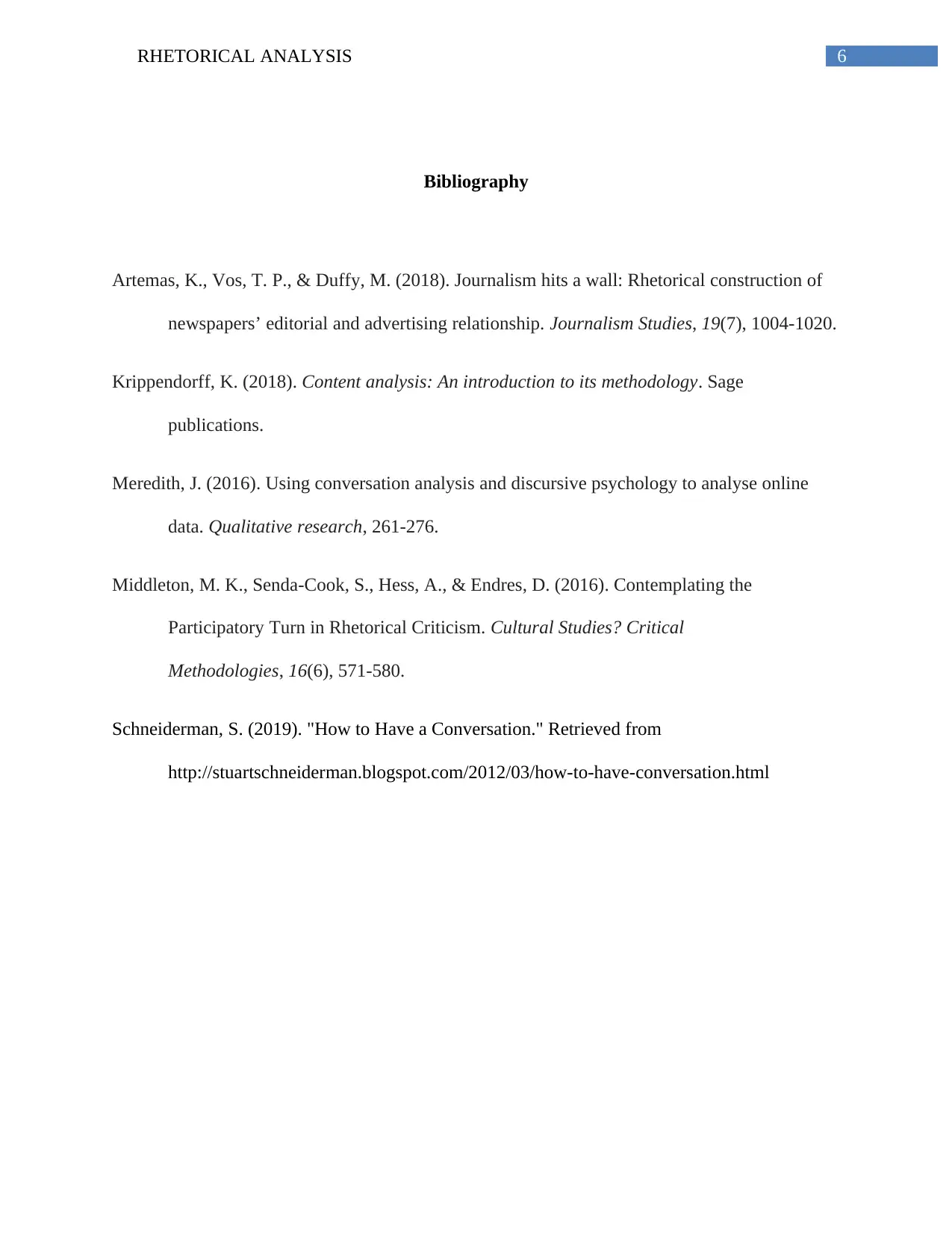Rhetorical Analysis Essay: McDermott's 'How to Have a Conversation'
VerifiedAdded on 2022/11/28
|6
|1274
|406
Essay
AI Summary
This essay performs a rhetorical analysis of John McDermott's article, "How to Have a Conversation." It explores how the author uses rhetorical devices, particularly metaphors, diction, and sentence structure, to convey his ideas effectively. The analysis highlights the impact of metaphors in conceptualizing ideas and capturing emotional states. The essay discusses McDermott's strategic use of diction to sustain interest and enrich the work, focusing on the connotations and literary impact of his word choices. Furthermore, it examines the author's varied sentence construction, including periodic sentences and unconventional grammar, as tools to create suspense, emphasize key points, and maintain reader engagement. The essay concludes that these rhetorical devices are not merely aesthetic but integral to the clarity, vividness, and overall effectiveness of McDermott's writing.

1RHETORICAL ANALYSIS
Rhetorical Analysis
Name of the Student
Name of the University
Author Note
Rhetorical Analysis
Name of the Student
Name of the University
Author Note
Paraphrase This Document
Need a fresh take? Get an instant paraphrase of this document with our AI Paraphraser

2RHETORICAL ANALYSIS
Topic- Rhetorical Analysis Essay
Introduction
The article of John McDermott titled as “ How to have a conversation” is nothing but the
writer’s journey who desired to investigate either the art of conversation can be taught in a
properly formal setting or not. He joined a professional conversation class in order to become a
great entertainer by the learnt skills. He realized after that the abstract ideas and the theories are
the main focus of the class. However, it could not obscure the useful lessons he had learnt from
the class regarding the purpose of conversation (Schneiderman, 2019). It is only through the use
of the rhetorical devices that the author expressed himself effectively, vividly and interestingly.
This paper will deal with the rhetorical analysis of John McDermott’s “ How to have a
conversation”.
The Rhetorical devices
The writer relied on the metaphors evident in the entire article in order to facilitate the
conceptualization of the ideas making his work effective and well understood. The Metaphors
are on the other hand brilliant in capturing the emotional state of an experience (Artemas, Vos &
Duffy, 2018). For the better understanding of their use, the literal language of McDermott can be
compared and contrasted with other articles. In the article of McDermott, there is a portion where
he says, “ none of my new friends said they wanted to be a raconteur in the Coleridge or the
Hitchens mould “. He selected to use the metaphor “ in the Hitchens mould “ for capturing the
quality being a fabulous conversationalist. He utilized Hitchens who is known in the world as an
example of a great conversationalist instead of describing all the conditions of his subject matter.
Topic- Rhetorical Analysis Essay
Introduction
The article of John McDermott titled as “ How to have a conversation” is nothing but the
writer’s journey who desired to investigate either the art of conversation can be taught in a
properly formal setting or not. He joined a professional conversation class in order to become a
great entertainer by the learnt skills. He realized after that the abstract ideas and the theories are
the main focus of the class. However, it could not obscure the useful lessons he had learnt from
the class regarding the purpose of conversation (Schneiderman, 2019). It is only through the use
of the rhetorical devices that the author expressed himself effectively, vividly and interestingly.
This paper will deal with the rhetorical analysis of John McDermott’s “ How to have a
conversation”.
The Rhetorical devices
The writer relied on the metaphors evident in the entire article in order to facilitate the
conceptualization of the ideas making his work effective and well understood. The Metaphors
are on the other hand brilliant in capturing the emotional state of an experience (Artemas, Vos &
Duffy, 2018). For the better understanding of their use, the literal language of McDermott can be
compared and contrasted with other articles. In the article of McDermott, there is a portion where
he says, “ none of my new friends said they wanted to be a raconteur in the Coleridge or the
Hitchens mould “. He selected to use the metaphor “ in the Hitchens mould “ for capturing the
quality being a fabulous conversationalist. He utilized Hitchens who is known in the world as an
example of a great conversationalist instead of describing all the conditions of his subject matter.

3RHETORICAL ANALYSIS
He also makes good use of the metaphor “we were Boswells, not Johnsons”. He also
tried his best to capture the well-meaning intentions and simplicity in one single word instead of
a plethora of the phrases The metaphors have further enabled the conceptualization of the
writer’s ideas through designing the work superiority. Taken for instance, the author also states
that “ they faced a white wall that had been attacked by black paint, which had left behind a
monochromatic mural”. It is where the writer sparks all his interest through the augmentation of
the metaphorical language. It can be said that it could have been less appealing for them to say
that their class room was having the black and white paint. Hence, it is pretty evident that the
metaphors are useful in creating a better understanding of what the writer had first experienced.
In this particular article, the writer has used diction for sustaining the interest in the piece
and at the same time enriching his own work. He used words such as “ raconteur “, “ raillery”
that had better synonyms such as “amusing speaker” and “ jest “ respectively . The issue is that
these words would not have incurred the same reaction as the choices of the author. The
selections of the words have successfully created a positive attitude towards the writer from the
readers as they give a proper impression of literary knowledge. Although these words are not
used in the regular language , there are some of the readers who would become attracted by th
words and apply in their language.
It is pretty sure that McDermott did not use the words meaninglessly or whimsically in
the article. He must have found the words to be the most effective for the expression of his
intentions. There are various synonyms of English which can be used to describe similar
situations but these words also can be used to allude to different aspects. Taken for another
instance, had the author desired to mock the American self help model, he would have addressed
the Americans to be “pretentious “, “fraudulent” or “overeager”. In that place, he described them
He also makes good use of the metaphor “we were Boswells, not Johnsons”. He also
tried his best to capture the well-meaning intentions and simplicity in one single word instead of
a plethora of the phrases The metaphors have further enabled the conceptualization of the
writer’s ideas through designing the work superiority. Taken for instance, the author also states
that “ they faced a white wall that had been attacked by black paint, which had left behind a
monochromatic mural”. It is where the writer sparks all his interest through the augmentation of
the metaphorical language. It can be said that it could have been less appealing for them to say
that their class room was having the black and white paint. Hence, it is pretty evident that the
metaphors are useful in creating a better understanding of what the writer had first experienced.
In this particular article, the writer has used diction for sustaining the interest in the piece
and at the same time enriching his own work. He used words such as “ raconteur “, “ raillery”
that had better synonyms such as “amusing speaker” and “ jest “ respectively . The issue is that
these words would not have incurred the same reaction as the choices of the author. The
selections of the words have successfully created a positive attitude towards the writer from the
readers as they give a proper impression of literary knowledge. Although these words are not
used in the regular language , there are some of the readers who would become attracted by th
words and apply in their language.
It is pretty sure that McDermott did not use the words meaninglessly or whimsically in
the article. He must have found the words to be the most effective for the expression of his
intentions. There are various synonyms of English which can be used to describe similar
situations but these words also can be used to allude to different aspects. Taken for another
instance, had the author desired to mock the American self help model, he would have addressed
the Americans to be “pretentious “, “fraudulent” or “overeager”. In that place, he described them
⊘ This is a preview!⊘
Do you want full access?
Subscribe today to unlock all pages.

Trusted by 1+ million students worldwide

4RHETORICAL ANALYSIS
as “ charlatans peddling snake oil for the soul “.This particular description clearly suggests
American self help groups to be teaching the skills which they do not have. It is undoubtedly a
difficult skill to master over and a symbol of the writer’s accomplishments (Krippendorff, 2018).
It would be difficult for the readers to understand the whole meaning of the article but they can
enjoy the themes, the cadence of the language and the literary exhibition of words. The meaning
can be concluded from the overall context and the unusual selection of words and it can be
helpful in understanding the essay (Meredith, 2016). It is highly impressive to see the author’s
choice of words because it renders the credibility to them and makes the overall work highly
appealing.
The style of his sentence construction is different and sustains the interest of the story
and further explains why a person should read till the end. The periodic sentences are visible in
different parts of the article and it is done by the author for emphasizing on his subject matter
and creating suspense in the work. It must also be noted that the periodic sentences have few
predicates in the very beginning apart from the clauses in the end. This particular method is both
ideal and climatic because it is always under analysis (Middleton et al., 2016). The author used
the method for achieving the variety of sentence. This specific piece would have become
monotonous if it stuck to the conventional construction of sentences.
In many parts, McDermott appears to be defying grammar and indicating that he has
inter-mingled both the formal and the informal writings. Taken for instance, he begins a sentence
with a preposition “And to have a bit of fun”. He has disregarded some traditional rules showing
his own versatility (Schneiderman, 2019).
Conclusion
as “ charlatans peddling snake oil for the soul “.This particular description clearly suggests
American self help groups to be teaching the skills which they do not have. It is undoubtedly a
difficult skill to master over and a symbol of the writer’s accomplishments (Krippendorff, 2018).
It would be difficult for the readers to understand the whole meaning of the article but they can
enjoy the themes, the cadence of the language and the literary exhibition of words. The meaning
can be concluded from the overall context and the unusual selection of words and it can be
helpful in understanding the essay (Meredith, 2016). It is highly impressive to see the author’s
choice of words because it renders the credibility to them and makes the overall work highly
appealing.
The style of his sentence construction is different and sustains the interest of the story
and further explains why a person should read till the end. The periodic sentences are visible in
different parts of the article and it is done by the author for emphasizing on his subject matter
and creating suspense in the work. It must also be noted that the periodic sentences have few
predicates in the very beginning apart from the clauses in the end. This particular method is both
ideal and climatic because it is always under analysis (Middleton et al., 2016). The author used
the method for achieving the variety of sentence. This specific piece would have become
monotonous if it stuck to the conventional construction of sentences.
In many parts, McDermott appears to be defying grammar and indicating that he has
inter-mingled both the formal and the informal writings. Taken for instance, he begins a sentence
with a preposition “And to have a bit of fun”. He has disregarded some traditional rules showing
his own versatility (Schneiderman, 2019).
Conclusion
Paraphrase This Document
Need a fresh take? Get an instant paraphrase of this document with our AI Paraphraser

5RHETORICAL ANALYSIS
Hence, it can be said that the rhetorical devices in the entire article function as more than
just the aesthetic reasons. The metaphors of McDermott have helped in the better understanding
of work through making them relatable. These are the devices which prove that the article is full
of creativity , vividness and clarity.
Hence, it can be said that the rhetorical devices in the entire article function as more than
just the aesthetic reasons. The metaphors of McDermott have helped in the better understanding
of work through making them relatable. These are the devices which prove that the article is full
of creativity , vividness and clarity.

6RHETORICAL ANALYSIS
Bibliography
Artemas, K., Vos, T. P., & Duffy, M. (2018). Journalism hits a wall: Rhetorical construction of
newspapers’ editorial and advertising relationship. Journalism Studies, 19(7), 1004-1020.
Krippendorff, K. (2018). Content analysis: An introduction to its methodology. Sage
publications.
Meredith, J. (2016). Using conversation analysis and discursive psychology to analyse online
data. Qualitative research, 261-276.
Middleton, M. K., Senda-Cook, S., Hess, A., & Endres, D. (2016). Contemplating the
Participatory Turn in Rhetorical Criticism. Cultural Studies? Critical
Methodologies, 16(6), 571-580.
Schneiderman, S. (2019). "How to Have a Conversation." Retrieved from
http://stuartschneiderman.blogspot.com/2012/03/how-to-have-conversation.html
Bibliography
Artemas, K., Vos, T. P., & Duffy, M. (2018). Journalism hits a wall: Rhetorical construction of
newspapers’ editorial and advertising relationship. Journalism Studies, 19(7), 1004-1020.
Krippendorff, K. (2018). Content analysis: An introduction to its methodology. Sage
publications.
Meredith, J. (2016). Using conversation analysis and discursive psychology to analyse online
data. Qualitative research, 261-276.
Middleton, M. K., Senda-Cook, S., Hess, A., & Endres, D. (2016). Contemplating the
Participatory Turn in Rhetorical Criticism. Cultural Studies? Critical
Methodologies, 16(6), 571-580.
Schneiderman, S. (2019). "How to Have a Conversation." Retrieved from
http://stuartschneiderman.blogspot.com/2012/03/how-to-have-conversation.html
⊘ This is a preview!⊘
Do you want full access?
Subscribe today to unlock all pages.

Trusted by 1+ million students worldwide
1 out of 6
Your All-in-One AI-Powered Toolkit for Academic Success.
+13062052269
info@desklib.com
Available 24*7 on WhatsApp / Email
![[object Object]](/_next/static/media/star-bottom.7253800d.svg)
Unlock your academic potential
Copyright © 2020–2025 A2Z Services. All Rights Reserved. Developed and managed by ZUCOL.